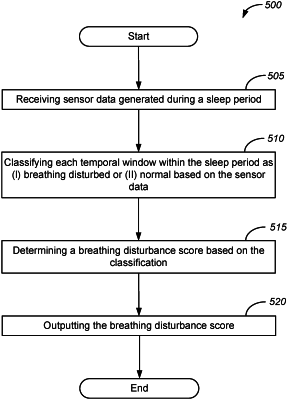| CPC A61B 5/4815 (2013.01) [A61B 5/0205 (2013.01); A61B 5/4818 (2013.01); A61B 5/7264 (2013.01); A61B 5/7267 (2013.01); A61B 5/01 (2013.01); A61B 5/02405 (2013.01); A61B 5/02427 (2013.01); A61B 5/067 (2013.01); A61B 5/082 (2013.01); A61B 5/0816 (2013.01); A61B 5/14532 (2013.01); A61B 5/14539 (2013.01); A61B 5/14542 (2013.01); A61B 5/369 (2021.01); A61B 5/389 (2021.01); A61B 5/4809 (2013.01); A61B 5/4812 (2013.01); A61B 5/681 (2013.01); A61B 2562/0219 (2013.01)] | 20 Claims |

|
1. A computer-implemented method, comprising:
determining a sleep period of a user using at least motion data of the user captured by one or more motion sensors;
determining, for the sleep period of the user, breathing disturbance data based at least in part on a decrease in blood oxygenation reflected in photoplethysmographic (PPG) data captured by one or more PPG sensors of a wearable device configured to be worn by the user;
calculating a sleep fitness score for the user over the sleep period, based at least in part on by classifying a plurality of temporal windows within the sleep period as representing disturbed breathing for the user or not breathing disturbed for the user according to the breathing disturbance data;
adjusting a duration of each of the plurality of temporal windows based on a sleeping or breathing pattern of the user; and
providing, for presentation on a display device, at least one of the sleep fitness score or the breathing disturbance data.
|